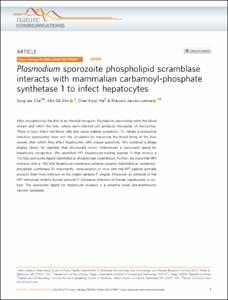Full metadata record
| DC Field | Value | Language |
|---|---|---|
| dc.contributor.author | Cha, Sung-Jae | - |
| dc.contributor.author | Kim, Min-Sik | - |
| dc.contributor.author | Na, Chan Hyun | - |
| dc.contributor.author | Jacobs-Lorena, Marcelo | - |
| dc.date.accessioned | 2021-12-08T12:00:09Z | - |
| dc.date.available | 2021-12-08T12:00:09Z | - |
| dc.date.created | 2021-12-06 | - |
| dc.date.issued | 2021-11 | - |
| dc.identifier.citation | Nature Communications, v.12, no.1 | - |
| dc.identifier.issn | 2041-1723 | - |
| dc.identifier.uri | http://hdl.handle.net/20.500.11750/15919 | - |
| dc.description.abstract | After inoculation by the bite of an infected mosquito, Plasmodium sporozoites enter the blood stream and infect the liver, where each infected cell produces thousands of merozoites. These in turn, infect red blood cells and cause malaria symptoms. To initiate a productive infection, sporozoites must exit the circulation by traversing the blood lining of the liver vessels after which they infect hepatocytes with unique specificity. We screened a phage display library for peptides that structurally mimic (mimotope) a sporozoite ligand for hepatocyte recognition. We identified HP1 (hepatocyte-binding peptide 1) that mimics a ~50 kDa sporozoite ligand (identified as phospholipid scramblase). Further, we show that HP1 interacts with a ~160 kDa hepatocyte membrane putative receptor (identified as carbamoyl-phosphate synthetase 1). Importantly, immunization of mice with the HP1 peptide partially protects them from infection by the rodent parasite P. berghei. Moreover, an antibody to the HP1 mimotope inhibits human parasite P. falciparum infection of human hepatocytes in culture. The sporozoite ligand for hepatocyte invasion is a potential novel pre-erythrocytic vaccine candidate. © 2021, The Author(s). | - |
| dc.language | English | - |
| dc.publisher | Nature Research | - |
| dc.title | Plasmodium sporozoite phospholipid scramblase interacts with mammalian carbamoyl-phosphate synthetase 1 to infect hepatocytes | - |
| dc.type | Article | - |
| dc.identifier.doi | 10.1038/s41467-021-27109-7 | - |
| dc.identifier.wosid | 000720682600006 | - |
| dc.identifier.scopusid | 2-s2.0-85119524588 | - |
| dc.type.local | Article(Overseas) | - |
| dc.type.rims | ART | - |
| dc.description.journalClass | 1 | - |
| dc.citation.publicationname | Nature Communications | - |
| dc.contributor.nonIdAuthor | Cha, Sung-Jae | - |
| dc.contributor.nonIdAuthor | Na, Chan Hyun | - |
| dc.contributor.nonIdAuthor | Jacobs-Lorena, Marcelo | - |
| dc.identifier.citationVolume | 12 | - |
| dc.identifier.citationNumber | 1 | - |
| dc.identifier.citationTitle | Nature Communications | - |
| dc.description.isOpenAccess | Y | - |
| dc.subject.keywordPlus | CIRCUMSPOROZOITE PROTEIN | - |
| dc.subject.keywordPlus | MALARIA SPOROZOITES | - |
| dc.subject.keywordPlus | KUPFFER CELLS | - |
| dc.subject.keywordPlus | SURFACE | - |
| dc.subject.keywordPlus | FALCIPARUM | - |
| dc.subject.keywordPlus | CANDIDATE | - |
| dc.subject.keywordPlus | MEMBRANE | - |
| dc.subject.keywordPlus | EFFICACY | - |
| dc.subject.keywordPlus | PARASITE | - |
| dc.subject.keywordPlus | MATRIX | - |
| dc.contributor.affiliatedAuthor | Cha, Sung-Jae | - |
| dc.contributor.affiliatedAuthor | Kim, Min-Sik | - |
| dc.contributor.affiliatedAuthor | Na, Chan Hyun | - |
| dc.contributor.affiliatedAuthor | Jacobs-Lorena, Marcelo | - |
- Files in This Item:
-
 기타 데이터 / 4.92 MB / Adobe PDF
download
기타 데이터 / 4.92 MB / Adobe PDF
download
- Appears in Collections:
- Department of New Biology Laboratory for QBIO and Precision Medicine 1. Journal Articles



